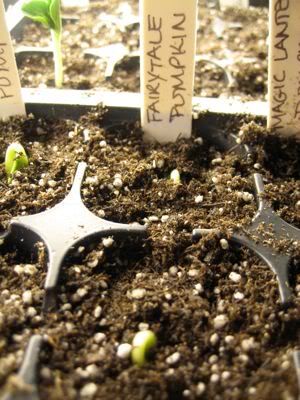Cucurbita spp.: A frosty field of bright orange pumpkins is a true sign of the harvest season. We offer the top varieties for holiday decoration, cooking, and exhibition.
CULTURE: Pumpkins have the same cultural needs as other members of the squash family. Refer to the Squash culture below, for direct sowing instructions. Starting transplants can give you earlier yields and prize winning pumpkins. Start transplants 3 weeks prior to your usual last frost. Use 3 inch peat or jiffy pots and grow with lots of light in a warm area. After they are up and growing well, move them to an outside cold frame. Hardening off for about a week makes a difference in their vigor after transplanting. After the danger of frost has passed, plant the entire peat or jiffy pot with no peat exposed to the air. Plant the bush or short-vine varieties in rows 6-8 feet apart with the plants spaced 3-4 feet apart in the row. Large-fruited varieties should be planted in rows 8-10 feet apart, with the plants spaced 4-5 feet apart in the row. Pumpkins and gourds require moderate to high levels of fertility. One cup of our complete fertilizer should be worked in around the plant when transplanting and another at the 4-6 leaf stage. Soil testing and liming to adjust pH can increase your success. Pumpkins and gourds require uniform irrigation totaling 15-20 inches of water during the growing season. Bee attractant flowers or beehives will help yields. Misshapen or non-developing fruit is often the result of poor pollination. All the gourds are vining varieties and can grow to 15 feet.
DISEASES: Pumpkins and gourds are susceptible to many of the common vine diseases, such as wilts, leaf spots and mildews, as well as several viral diseases. Common control measures include crop rotation, field sanitation, and fungicide applications. Consult your local county extension agent with specific problems.
INSECTS: Cucumber beetles and squash bugs can cause problems in squash plants. We've seen striped cucumber beetles turn healthy leaves into something that resembles a nylon sack in a matter of days. Dedicated use of Rotenone-Pyrethrin will help control the problem. Crop rotation can minimize problems with insects.
HARVEST: Exposure in the field to prolonged (1-2 weeks) temperatures below 50°F can result in chilling injury and lead to pumpkins and gourds rotting in storage. Pumpkins can be harvested after their rinds are hard and their skins have turned orange. Leave 3-4 inches of stem on the fruit since pumpkins without stems store poorly. Gourds should be allowed to mature as long as possible on the vine. To dry gourds, first wash gently in a solution of 10 parts water and 1 part bleach, carefully removing all dirt, then store in a warm, dry location. Pumpkins and gourds should be stored at 55-70°F and at 70% relative humidity.
SEED SPECS: Minimum germination standard: 75%. Usual seed life: 3 years. See individual varieties for seed count. There are 28 grams per ounce.
SQUASH
CULTURE: Squash and pumpkins prefer good fertile soil and plenty of sunshine. Start indoors or in a greenhouse 3 weeks prior to your last frost. Sow in a 3 inch peat pot or jiffy pot for direct transplanting. For best results transplant prior to the second set of true leaves. Work 1 cup of our complete fertilizer into the soil around each plant. For direct sowing, plant after your last frost and when the soil has warmed to at least 60°F. Optimum soil temperature for germination: 65-80°F. Days to germination: 5-10. Sow 1 inch deep and 24 inches between bush varieties, 36 inches between vining varieties. Squash needs just-barely-damp soils to germinate. Too much moisture causes the seed to rot. All squash are monoecious (bearing separate male and female flowers on the same plant), and require bee and insect activity for successful pollination. Poor fruit set is often the result of poor pollination.
INSECTS/PESTS: The major insect pests are the spotted and striped cucumber beetles, vine borers and squash bugs. Use row covers and/or apply Rotenone to reduce and control damage. Butternut varieties have a solid stem and are resistant to vine borer damage.
DISEASES: Squash are susceptible to a number of fungal, bacterial, and viral diseases that vary between regions. Your local county extension agent can help you pinpoint your particular problem.
HARVEST: Pick baby summer squash as well as the more mature ones. In general, summer squash are most tender and flavorful when very young. Winter squash are best left on the vine until fully mature. It should require quite a bit of pressure before your fingernail pierces through the rind into the flesh. For the best sugar content, cut the stem an inch or so from the body after the first light frost, and if the weather is dry, let them cure in the field. If temperatures drop below 25°F, bring your harvest inside and store in a cool dry location.
SEED SPECS: Minimum germination standard: 75%. Usual seed life: 3-4 years. Days to maturity: from date of direct seeding; if transplanting, subtract 10 days.
Seeds per gram listed below by type; 28 grams per ounce.
----------
PURCHASED: 3g from Territorial Seed Co. Feb '09. $2.75
STARTED SEED: Planted seeds on 3/22. They came up on 3/24. Two days! How crazy is that?
HARDENED OFF:
TRANSPLANTED IN GARDEN:
DISEASE ISSUES:
INSECT ISSUES:
HARVEST YEILD & DURATION:
OTHER NOTES:
03/24/09

No comments:
Post a Comment